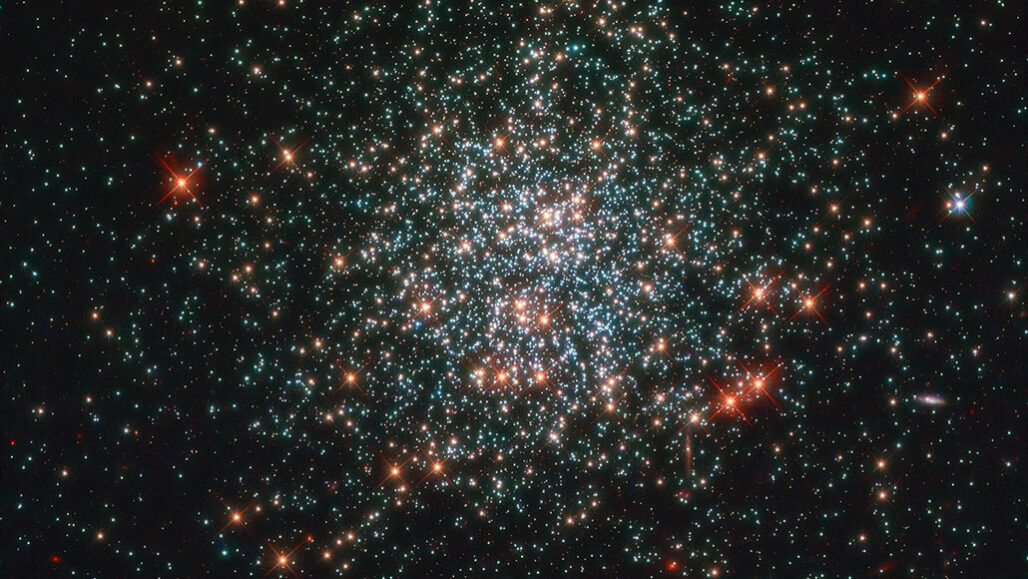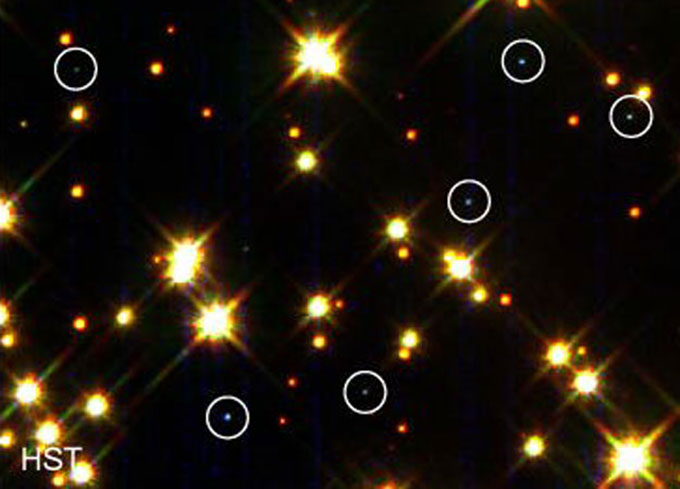Explainer: Stars and their families
The sun and its kin are glowing infernos that are born, die and forge new elements

This image from the Hubble Space Telescope shows a star cluster known as NGC 2203. Many of its stars are twice as massive as our sun.
ESA/Hubble & NASA, L. Girardi
By Ken Croswell
A star is a celestial object whose surface is so hot that it emits light. How hot? Most are thousands of degrees hotter than your kitchen’s oven. And it doesn’t matter what scale you use. For example, our sun — the closest star — is 5,510° Celsius, 9,940° Fahrenheit or 5,780 kelvins. (Kelvin, which uses no “degree” designation, is the temperature scale astronomers use.) It is because stars glow this hot that we can see them from even trillions of miles away.
Our sun looks different from other stars simply because it’s much closer. Earth and our solar system’s other planets orbit the sun. Unlike a star, a planet does not make its own light. When you see a planet, such as Mars or Saturn, you’re really only seeing light from the sun that is bouncing off the planet.

A star is born over a long span of time from a large, cold, dark cloud of gas and dust. Eventually, gravity causes the cloud’s constituents to clump together. Parts of the cloud come crashing into the center, heating it up. At some point, the cloud’s center gets so hot it starts to shine — and a new star is born.
Then the star’s center gets so hot that protons — tiny particles, each with a positive electric charge — hit each other and stick together. This makes energy. A proton is the nucleus, or center, of a hydrogen atom. So we call these reactions nuclear reactions. Nuclear reactions power the sun and most other stars. They do that for a long time but not forever.
In fact, the more massive a star is, the sooner it dies. Why? Massive stars shine very brightly because they’re using up their fuel quickly. The most massive stars live for millions of years. Stars like our sun live for many billions. But some of the least massive stars can shine on for trillions of years. (That’s several million million years.)
Ending with bang … or quiet cooling?
Most massive stars end their lives with an explosion. Astronomers describe these celestial fireworks as a supernova. Such an event ejects most of the mass of a star into space.
The rest of the star’s mass collapses into a small core just a few kilometers (miles) across. In most cases, negatively charged particles called electrons and positively charged particles called protons fuse into neutral particles called neutrons. The result is a neutron star. Its core is so dense that a single teaspoonful of neutron star material would weigh more than a billion tons on Earth.
In some cases, though, the core collapses inward to form a black hole. This object is so dense that nothing — not even light — can escape it.
Less massive stars, such as our sun, die more gently.
For most of its adult life, a yellow “main-sequence” star, such as our sun, burns fuel steadily. (Our 4.6-billion-year-old sun has enough fuel to shine for nearly another 8 billion years.) These stars run out of fuel at their center, however, as they enter old age. Then they begin to burn hydrogen in a shell surrounding the center. This makes the star expand, causing its surface to cool and turn red. Now the star is a red giant. For a sun-like star, this phase can last a billion years or two.
During its red-giant phase, a star loses mass. Eventually its outer layers disappear, exposing the hot core. Only about the size of Earth, this core is still massive. In fact, it typically has nearly as much mass as the mid-life sun.
Dwarfs abound
This hot core is known as a white dwarf. Having turned off its nuclear furnace, the star now enters a cooling phase. Over billions of years, it will shed light and heat until it goes dark.

Some five in every 100 stars in the universe are white dwarfs. The nearest is just 8.6 light-years away. (A light-year is the distance light travels in one year across empty space.) But white dwarfs are so faint that you can’t see any of them with the unaided eye. Telescopes such as the Hubble Space Telescope, however, have pictured many.
A different type, red dwarfs, outnumber all other stars put together. Born with much less mass than the sun, these stars shine faintly. About three out of every four stars are red dwarfs. But they are so dim that you can’t see any without using binoculars or a telescope.
Then there are brown dwarfs. A brown dwarf is born with so little mass that it can’t sustain nuclear-fusion reactions. When young, a brown dwarf glows from the heat of its birth. It looks red, like a red dwarf. But then it cools, eventually fading to black. Still, astronomers can see brown dwarfs because the youngest ones do emit light. And astronomers also can detect older brown dwarfs as they continue to give off heat.
Star families
Some stars, such as the sun, are loners. Others live in big families known as clusters. Clusters are often temporary communities. Most don’t survive for more than a billion years. Our sun is already more than four times that old, so it could have spent its childhood as part of a cluster that later broke up (as the Hyades cluster is doing right now).

Meanwhile, even loners are part of enormous communities known as galaxies. Where a cluster may hold a few thousand stars, a galaxy can be home to far more. Our galaxy, the Milky Way, has hundreds of billions of stars. And galaxies abound. Our universe hosts trillions of them.
There are even communities bigger than galaxies. Galaxy clusters can each contain thousands of galaxies.
Most stars everywhere are creating new chemical elements. After the Big Bang, the universe consisted of hydrogen, helium and a little lithium. Converting lightweight elements into heavier ones is what most stars do.
Massive stars made most of the oxygen we breathe. Less massive stars made most of the nitrogen, and both types made carbon. Exploding white dwarf stars made most of the iron in our blood. So it’s fair to say that we and everything else in our world are essentially made from what was once stardust.







